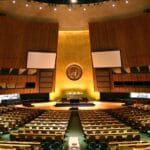Radiological materials and the Nuclear Security Summit
By Fissile Materials Working Group | December 21, 2011
With the second Nuclear Security Summit fast approaching, it is a good moment to reflect on one of the new issues with which the Seoul summit will attempt to grapple: radiological security. The first Nuclear Security Summit in Washington focused on weapons-usable nuclear materials — highly enriched uranium and plutonium. The rationale behind a strictly defined agenda was to attract attention to the materials that pose the gravest dangers, as they can be used in a nuclear weapon. The organizers of the second summit, however, have expanded the agenda to include issues pertaining to radioactive materials.
Radiological terrorism: Assessing the threat. When discussing radiological terrorism, policy makers need to have a correct understanding of the threat. Not all radioactive sources are created equal. A smoke detector, for example, which contains a miniscule amount of radioactive material, would not make a very good dirty bomb; but a large-curie source stolen from a nuclear medicine facility might. There are only a handful of high-risk radioisotopes that deserve heightened attention: cobalt-60, cesium-137, iridium-192, strontium-90, americium-241, californium-258, plutonium-238, and radium-226. Focusing on this specific category of high-risk radioactive sources should be the summit’s key priority.
There are several challenges that the international community faces when addressing the risks posed by radioactive sources. First, while only specific radioisotopes pose a high security risk, many countries lack the institutional mechanisms for accounting and control of radioactive sources present on their territory, including how many sources fall into the high-risk category. “Orphaned” radioactive sources, which have been abandoned by military and industry and remain unaccounted for, pose a particularly acute problem for many governments. The deadliest accident involving an orphaned source happened in Goiania, Brazil. During a move to new premises, a medical institution abandoned a teletherapy unit that contained cesium-137. When picked up and dismantled by unsuspecting local residents, the radioactive material it contained caused four deaths and numerous injuries. The accident is just one component of a broader challenge to governments around the world to regulate disused sources and ensure companies and facilities dispose of used sources in a safe and secure manner.
Second, compounding the challenge of regulation is the fact that radioactive material, unlike nuclear material, has numerous benign applications. For example, industry, hospitals, and universities use radioactive material to improve quality of life. And unlike nuclear material, which is limited to a small number of countries, radioactive material is present in almost every country in the world. The legal security architecture for radioactive material is considerably less developed compared with that of nuclear material. The International Atomic Energy Agency (IAEA) has developed a non-legally binding “Code of Conduct on the Safety and Security of Radioactive Sources” and a supplementary “Guidance on the Import and Export of Radioactive Sources.” Security of nuclear material, on the other hand, has much stronger underpinnings. The “Convention on the Physical Protection of Nuclear Material” establishes legal obligations of state parties in the area of physical protection of nuclear material. The IAEA also developed “Nuclear Security Recommendations on the Physical Protection of Nuclear Material and Nuclear Facilities” (INFCIRC/225). Yet radioactive material is more vulnerable to theft than nuclear material. Nuclear material is usually stored in secure facilities; radioactive material can be found in places with minimal to no physical protection and near-unlimited accessibility. For example, hospitals that use radioactive material are open to the public 24 hours a day and have no trained security force.
Finally, since the use of radioactive material is so widespread, enforcing controls on its transfer is a much more difficult task than that of highly controlled nuclear material. The detection of unauthorized transfers of radioactive material depends on the diligence of customs and border enforcement agencies around the world. Many developing countries, however, lack even rudimentary detection equipment or the training to enforce such controls.
The risks of radiological terrorism are not limited to dirty bombs. Would-be radiological terrorists can also attack nuclear facilities with the aim of dispersing radioactivity. Even relatively secure nuclear power plants, spent-fuel facilities, reprocessing plants, and high-level waste storage facilities are vulnerable to attack or sabotage. The Fukushima tragedy, though not a terrorist act, demonstrated the all-too-severe reality of events involving high-level radioactivity.
Radioactive materials on the Nuclear Security Summit agenda. Incorporating security of radioactive material on the Nuclear Security Summit agenda might seem like an uncontroversial step, but some states have opposed its inclusion. Expanding the agenda, they argue, might draw attention away from or dilute the original objective of the summit process — securing vulnerable weapons-grade nuclear materials. Moreover, because radiological security is relevant not only to states that are currently members of the summit process, but to practically all countries in the world — most of which use radiological materials for agriculture, oil, science, and medicine — the question of summit membership is raised with the expansion of the agenda. Should the Nuclear Security Summit involve any interested states with radiological materials in the process as informal summit participants? It would involve a substantial effort as radioactive materials are mainly used by industries and are not in immediate government control (like nuclear material). This might prove to be too challenging a task to manage.
Nonetheless, expanding the summit agenda is important. It reflects the legitimate concern of many countries about threats of radiological terrorism. After all, though most developed nations see nuclear terrorism as an imminent threat that calls for the immediate securing of nuclear materials, many countries are more concerned with radiological terrorism — because they believe that given the accessibility of radiological materials, it is the more likely threat.
Including discussion about radiological terrorism on the agenda will bring high-level political attention to the problem. As the first Nuclear Security Summit demonstrated, summit diplomacy drove bold actions on behalf of governments in securing vulnerable nuclear material. The summit process is not a panacea and cannot and should not substitute for existing frameworks and mechanisms for minimizing risks associated with radioactive material. But it can highlight more of the world’s most pressing concerns and spur action on securing high-risk radioactive sources.
Editor’s Note: This column was written by Togzhan Kassenova, a member of the Fissile Materials Working Group. Kassenova is an associate in the Nuclear Policy Program at the Carnegie Endowment and a Stanton nuclear security fellow.
Together, we make the world safer.
The Bulletin elevates expert voices above the noise. But as an independent nonprofit organization, our operations depend on the support of readers like you. Help us continue to deliver quality journalism that holds leaders accountable. Your support of our work at any level is important. In return, we promise our coverage will be understandable, influential, vigilant, solution-oriented, and fair-minded. Together we can make a difference.
Topics: Columnists, Nuclear Weapons















